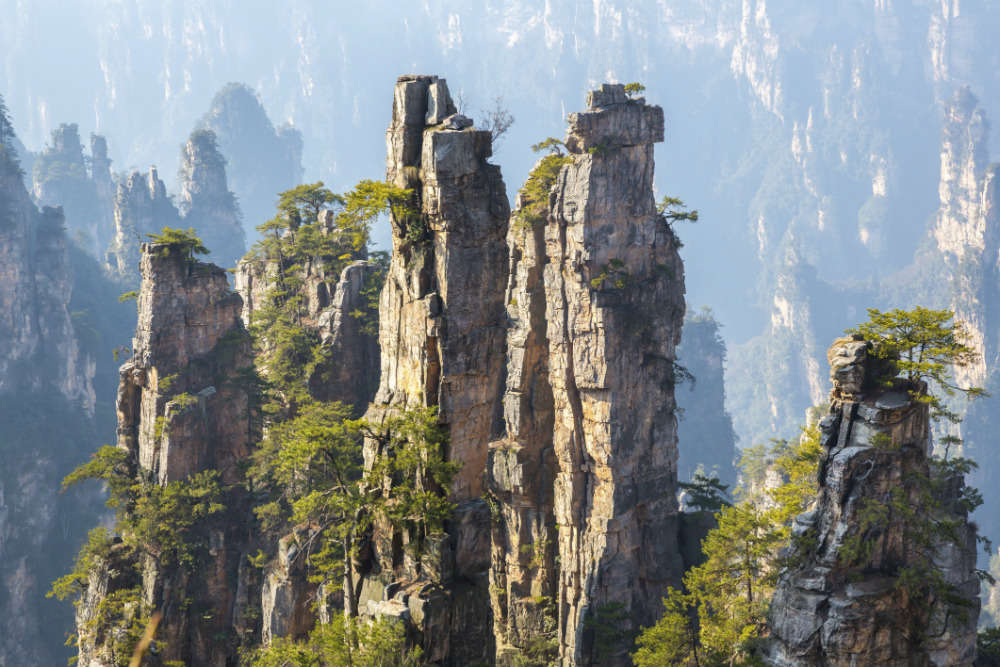
Why Does Zhangjiajie Look the Way it Does?
Zhangjiajie National Forest Park in China is famous for its towering sandstone pillars that look like something out of a fantasy movie. These unique formations attract millions of visitors each year, all eager to wander through the otherworldly landscape. But what geological processes created such a striking vista?
Similarities and Differences with Karst Terrain
Some have compared the terrain of Zhangjiajie to the karst landscapes found in Slovenia and other parts of the world. While there are some superficial similarities, a closer look reveals that Zhangjiajie's topography is unique.
| Feature | Karst Terrain | Zhangjiajie Terrain |
|---|---|---|
| Rock Type | Primarily limestone, sometimes dolomite | Quartz sandstone |
| Formation Process | Dissolution of rock by acidic water | Erosion by water, weathering, gravity collapse |
| Typical Features | Caves, sinkholes, underground rivers | Towering pillars, deep ravines, lush vegetation |
While both karst and Zhangjiajie landscapes feature dramatic vertical relief, the underlying geological processes are different. Karst landscapes are formed primarily by the dissolution of soluble rock like limestone by acidic water, leading to the creation of caves, sinkholes, and underground rivers.
The Unique Geology of Zhangjiajie
Zhangjiajie's iconic pillars, on the other hand, are composed of quartz sandstone, a rock type not easily dissolved by water. So how did these dramatic formations come to be?
Geologists point to a combination of factors:
1. Special Rock Strata:
The sandstone formations in Zhangjiajie were laid down in a shallow sea over 300 million years ago. These layers of sand were interspersed with layers of more resistant rock, creating a vertically stacked structure.
2. Tectonic Uplift:
Millions of years later, tectonic activity caused the entire region to uplift, tilting the once-horizontal layers of sandstone. This uplift exposed the rock to the forces of erosion.
3. Subtropical Climate and Water Erosion:
The warm, humid climate of Zhangjiajie provided ideal conditions for weathering and erosion. Rainwater, slightly acidic due to dissolved carbon dioxide, seeped into cracks and fissures in the sandstone. Over time, this process widened the cracks, further fragmenting the rock.
4. Freeze-Thaw Cycles:
During colder periods, water trapped in the cracks would freeze and expand, putting further pressure on the rock and contributing to its breakdown.
5. Gravity Collapse:
As the erosion process continued, undercutting the base of the sandstone pillars, gravity played its part. Large sections of rock would periodically collapse, leaving behind the isolated towers we see today.
A Dynamic Landscape
It's important to remember that the landscape of Zhangjiajie is not static. The forces of erosion are still at work, constantly reshaping the sandstone pillars. While this slow and gradual process might not be noticeable on a human timescale, it serves as a reminder of the immense power of nature and the ever-changing face of our planet.
Q&A
1. Are the sandstone pillars in Zhangjiajie hollow?
No, the sandstone pillars in Zhangjiajie are not hollow. They are solid formations of quartz sandstone, though they may contain internal cracks and fissures created by erosion.
2. How tall are the tallest sandstone pillars in Zhangjiajie?
Some of the tallest sandstone pillars in Zhangjiajie reach heights of over 1,000 meters (3,280 feet), making for a truly awe-inspiring sight.
3. Is it safe to visit Zhangjiajie National Forest Park?
Yes, Zhangjiajie National Forest Park is generally safe to visit. Well-maintained walkways, paths, and viewing platforms have been constructed throughout the park to ensure visitor safety. However, it is essential to follow park regulations and heed any safety guidelines provided.